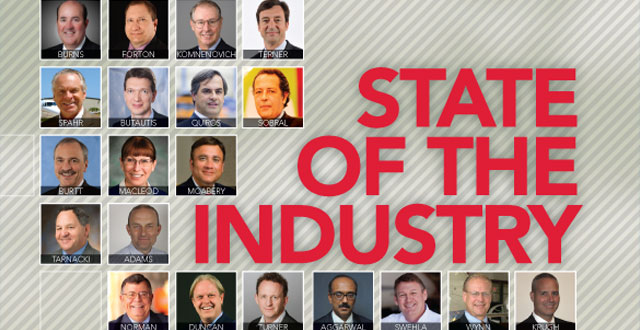
The FAA released its annual forecast for the aviation industry in March. This report takes a look back at the previous year (2012) and then makes some predictions for the long range. I find predictions something to be leery of and that is one reason we don’t ask our “State of the Industry” responders to peer into the crystal ball (see story starting on page 22). We only ask about the current state of our business and what trends these leaders are seeing. I find this much more concrete and from these responses, readers can make their own judgements.
The FAA Forecast begins in this way, “Developing forecasts of aviation demand and activity levels continues to be challenging as the aviation industry evolves and prior relationships change. In times of amplified volatility, the process is filled with uncertainty, particularly in the short-term.” And adds, “The intent of these forecasts is to accurately predict future demand; however, due to the large uncertainty of the operating environment, the variance around the forecasts is wider than it was in prior years.”
But the FAA’s Annual Forecast has some interesting insights.
In a first this year, the FAA has changed its model for the U.S. domestic market from a GDP-based model to a model based on real disposable personal income (DPI). They say they have done this because they believe that aviation demand depends on the level of business and leisure activity in the economy. In addition, the report says “any changes in future tax policy that impact individual taxes will be more directly reflected in changes to DPI as opposed to GDP.” Taking this into consideration, the FAA now says disposable income, rather than GDP, is a better metric to use for forecasting future demand.
Some key insights from the forecast are a predicted modest pace of economic recovery with inflation remaining in check. The forecast period is 2013-2033. The FAA’s baseline forecast assumes that the economy recovers from the current downturn and suffers “no major mishaps such as large oil price shocks, swings in macroeconomic policy, or financial meltdowns.”
As we have been seeing for the last several years, the Asia/Pacific and Latin America/Caribbean regions will continue to have the highest growth rates. China is projected to become the world’s second largest economy by 2013 (surpassing Japan). And India is projected to see its GDP quadruple in size, growing at an average rate of 6.9 percent a year during the forecast period.
The forecast says commercial aviation system capacity is projected to decline slightly in 2013 and that load factors are projected to grow slightly during the early years of the forecast period and then growth will slow during the mid to latter years.
The U.S. commercial airline fleet has contracted by 713 aircraft since 2007. The forecast says the number of commercial aircraft will grow from 7,024 in 2012 to 8,554 in 2033 and after 2013, the mainline air carrier passenger fleet increases an average of 58 aircraft a year over the remaining years of the forecast period, totaling 4,907 aircraft in 2033. The narrow-body fleet (including E-190’s at JetBlue and U.S. Airways) is projected to grow by 28 aircraft annually over the period 2012-2033; the wide-body fleet grows by 26 aircraft a year as the Boeing 787 and Airbus A350’s enter the fleet. After 2013, the regional carrier fleet is expected to increase by an average of 5 aircraft (0.2 percent) a year over the remaining years of the forecast period, totaling 2,436.
According to the FAA turboprop/piston aircraft are expected to account for only 14.5 percent of the regional carrier passenger fleet in 2033, down from a 31.5 percent share in 2012. The report says the business jet market calls for strong growth in the long term, driven by higher corporate profits and the growth of worldwide GDP.
A particularly fascinating section of the report addressed unmanned aircraft systems (UAS) and says they are currently the most dynamic growth sector within the aviation industry. The FAA forecasts the largest growth in civil and commercial unmanned operations will be in the area of small unmanned aircraft systems (sUAS).
And of course it concludes with this statement, “Uncertainty exists in all industries, but especially in the commercial air travel industry.”
Forecasts frustrate me. I’ve read my fair share of them over the years only to see later how very wrong they were. So when there is a new one, I read it with a grain of salt. Anything can happen and we have seen some of the most unbelievable things happen in the last 10-15 years to include aircraft being highjacked and flown into skyscrapers, wildly fluctuating oil prices, natural disasters such as hurricanes, tsunamis and volcanic eruptions, public humiliation of those who use aircraft as legitimate business tools and so much more that influences how much we fly.
Who can predict what will happen next? The truth is, no one can. The next big influence on the usage of commercial, business or general aviation aircraft will be something no one has thought to include in a forecast because it is simply stranger than fiction.
Having said that, I guess we have to try to understand, to the best of our human abilities, where the industry is headed. In this way, we can attempt to plan and set goals for our businesses.
In that endeavor, I wish you the best of luck. You can find the complete FAA Forecast at www.faa.gov.
[s2If is_user_logged_in()]
READ FULL STORY >>>
[/s2If]
[s2If is_user_not_logged_in()]
[message_box title=”To READ the full article in our digital edition you need to be a registered subscriber to the magazine – If you are NOT then goto the SUBSCRIBE section of the site first before you can login” color=”green”]
[/message_box]
[/s2If]
